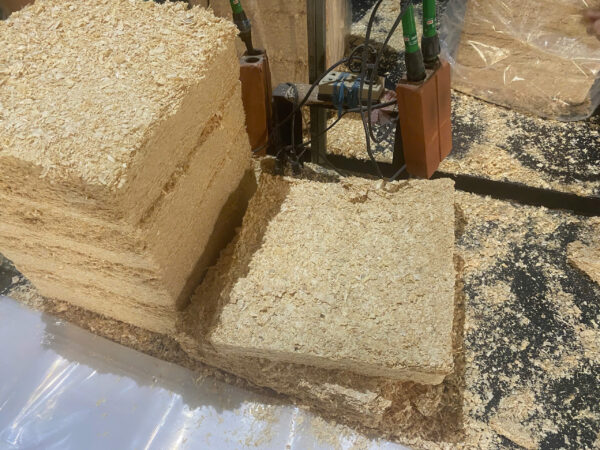Pine Wood Shavings are a natural product widely favored as bedding material for livestock and poultry due to their excellent absorption, effective odor control, and eco-friendly properties. This material not only provides comfort for animals but also helps maintain hygiene in farming environments. However, after being used as bedding, many people discard them without realizing their potential for reuse, resulting in the waste of valuable resources. This article offers detailed methods to reuse pine wood shavings after use as bedding, helping you save costs while contributing positively to environmental conservation.
Reuse in Organic Fertilizer Production Of Wood Shavings

Pine wood shavings used as bedding accumulate organic matter from animal waste and urine, making them an ideal base for composting. This process transforms waste into a valuable asset for agriculture, offering long-term benefits for soil health. You can start by mixing the shavings with additional materials such as fruit peels, dry leaves, or grass to enhance the natural decomposition process and boost the presence of beneficial microorganisms in the mixture.
After composting in well-ventilated conditions with appropriate moisture levels for approximately 6-8 weeks, you will obtain nutrient-rich organic fertilizer containing essential elements like nitrogen, phosphorus, and potassium. This product improves soil quality by increasing its porosity and water retention capacity, supporting robust plant growth and boosting crop yields. Moreover, reusing shavings in this manner significantly reduces environmental waste, providing lasting benefits for both farmers and the local ecosystem.
Use as Ground Cover Material – Wood Shavings

Pine wood shavings used as bedding can be repurposed as a natural ground cover for gardens or farms after removing larger debris like leftover manure. The process is straightforward: simply spread a thin layer of shavings over the soil surface to retain moisture, prevent weed growth, and protect plant roots from extreme temperatures such as intense heat or winter cold. This method is particularly useful in regions with fluctuating climates, ensuring stability for plant growth throughout the seasons.
As the shavings break down over time, they enhance soil structure by improving its porosity and water-holding capacity, creating optimal conditions for root development. Additionally, this ground cover adds a natural aesthetic to your garden, enhancing its visual appeal and attracting gardening enthusiasts. This cost-effective and sustainable solution is especially suitable for households or farmers looking to maximize available resources without incurring significant additional expenses.
Recycling into Fuel Material
Pine wood shavings used as bedding, when thoroughly dried and cleaned of impurities, can be recycled into a natural fuel source, providing an efficient alternative energy option. The process requires careful cleaning to remove any remaining manure or dirt, followed by drying under sunlight or in a drying oven to minimize moisture content. Once prepared, you can compress the shavings into pellets or use them directly in wood stoves, ovens, or fireplaces to generate heat.
The calorific value of pine wood shavings remains high even after processing, offering a cost-effective substitute for fossil fuels like coal or fuel oil, which are becoming increasingly expensive. However, to ensure safety and efficiency, it’s crucial to thoroughly check for impurities that could produce toxic smoke or reduce combustion quality, especially in enclosed spaces like kitchens or heating rooms. This method not only reuses waste but also reduces reliance on non-renewable energy sources.
Application in Food Processing
Pine wood shavings used as bedding hold great potential in food processing as a natural material for smoking food, imparting a unique flavor when properly treated. The treatment process involves soaking the shavings in water for several hours to eliminate bacteria and odors, followed by thorough drying and hygiene checks to meet food safety standards. Pine wood is particularly prized for its distinctive aroma, making it a popular choice for smoking products like cured meats, dried fish, or cheese, often featured on the menus of upscale restaurants.
This approach not only reuses waste but also opens new business opportunities for individuals or small enterprises interested in artisanal food production. Incorporating pine wood shavings into the smoking process can yield high-value products while maximizing the use of available resources and reducing the amount of waste that requires disposal. However, strict adherence to hygiene regulations is essential to ensure product quality and safety, particularly when introducing these items to commercial markets.
Conclusion

Reusing pine wood shavings after use as bedding offers significant economic and environmental benefits, enabling you to save costs effectively over the long term. From producing organic fertilizer to improve soil health, using them as ground cover to protect plants, recycling into fuel to conserve energy, to applying them in food processing to create commercial value, this product demonstrates immense potential in transforming waste into valuable assets. Start implementing these methods today to optimize resources and contribute to a more sustainable future for your community, especially in the face of escalating climate change challenges.
For more detailed information about pine wood shavings or related products, including purchasing options and technical advice, please contact us via hotline [Your Phone Number] or visit [Your Website]. With these strategies, you can minimize your environmental footprint while unlocking sustainable economic growth opportunities for your household or business.
